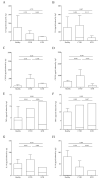BNT162b2 Elicited an Efficient Cell-Mediated Response against SARS-CoV-2 in Kidney Transplant Recipients and Common Variable Immunodeficiency Patients
- PMID: 37632002
- PMCID: PMC10459971
- DOI: 10.3390/v15081659
BNT162b2 Elicited an Efficient Cell-Mediated Response against SARS-CoV-2 in Kidney Transplant Recipients and Common Variable Immunodeficiency Patients
Abstract
SARS-CoV-2 vaccination is the standard of care for the prevention of COVID-19 disease. Although vaccination triggers both humoral and cellular immune response, COVID-19 vaccination efficacy is currently evaluated by measuring antibodies only, whereas adaptative cellular immunity is unexplored. Our aim is to test humoral and cell-mediated response after three doses of BNT162b vaccine in two cohorts of fragile patients: Common Variable Immunodeficiency (CVID) patients and Kidney Transplant Recipients (KTR) patients compared to healthy donors. We enrolled 10 healthy controls (HCs), 19 CVID patients and 17 KTR patients. HC BNT162b third dose had successfully mounted humoral immune response. A positive correlation between Anti-Spike Trimeric IgG concentration and neutralizing antibody titer was also observed. CVID and KTR groups showed a lower humoral immune response compared to HCs. IFN-γ release induced by epitopes of the Spike protein in stimulated CD4+ and CD8+ T cells was similar among vaccinated HC, CVID and KTR. Patients vaccinated and infected showed a more efficient humoral and cell-mediated response compared to only vaccinated patients. In conclusion, CVID and KTR patients had an efficient cell-mediated but not humoral response to SARS-CoV-2 vaccine, suggesting that the evaluation of T cell responses could be a more sensitive marker of immunization in these subjects.
Keywords: cell-mediated immunity; humoral immunity; immunodeficiency; mRNA vaccine.
Conflict of interest statement
The authors declare no conflict of interest.
Figures




Similar articles
-
Immunogenicity of Anti-SARS-CoV-2 Vaccines in Common Variable Immunodeficiency.J Clin Immunol. 2022 Feb;42(2):240-252. doi: 10.1007/s10875-021-01174-5. Epub 2021 Nov 17. J Clin Immunol. 2022. PMID: 34787773 Free PMC article.
-
Elevated CD21low B Cell Frequency Is a Marker of Poor Immunity to Pfizer-BioNTech BNT162b2 mRNA Vaccine Against SARS-CoV-2 in Patients with Common Variable Immunodeficiency.J Clin Immunol. 2022 May;42(4):716-727. doi: 10.1007/s10875-022-01244-2. Epub 2022 Mar 15. J Clin Immunol. 2022. PMID: 35290571 Free PMC article. Clinical Trial.
-
Specific Antibody and the T-Cell Response Elicited by BNT162b2 Boosting After Two ChAdOx1 nCoV-19 in Common Variable Immunodeficiency.Front Immunol. 2022 Jun 17;13:907125. doi: 10.3389/fimmu.2022.907125. eCollection 2022. Front Immunol. 2022. PMID: 35784359 Free PMC article.
-
Easy approach to detect cell immunity to COVID vaccines in common variable immunodeficiency patients.Allergol Immunopathol (Madr). 2022 May 1;50(3):101-105. doi: 10.15586/aei.v50i3.583. eCollection 2022. Allergol Immunopathol (Madr). 2022. PMID: 35527662 Review.
-
Influenza Vaccination in Patients with Common Variable Immunodeficiency (CVID).Curr Allergy Asthma Rep. 2017 Oct 5;17(11):78. doi: 10.1007/s11882-017-0749-3. Curr Allergy Asthma Rep. 2017. PMID: 28983790 Review.
Cited by
-
Impact of Exposure to Vaccination and Infection on Cellular and Antibody Response to SARS-CoV-2 in CVID Patients Through COVID-19 Pandemic.J Clin Immunol. 2023 Dec 22;44(1):12. doi: 10.1007/s10875-023-01616-2. J Clin Immunol. 2023. PMID: 38129351
-
When Cell-Mediated Immunity after Vaccination Is Important.Pathogens. 2024 Jan 9;13(1):65. doi: 10.3390/pathogens13010065. Pathogens. 2024. PMID: 38251372 Free PMC article.
-
Clinical and Analytical Performance of ELISA Salivary Serologic Assay to Detect SARS-CoV-2 IgG in Children and Adults.Antibodies (Basel). 2024 Jan 5;13(1):6. doi: 10.3390/antib13010006. Antibodies (Basel). 2024. PMID: 38247570 Free PMC article.
-
An Overview of the Strategies to Boost SARS-CoV-2-Specific Immunity in People with Inborn Errors of Immunity.Vaccines (Basel). 2024 Jun 18;12(6):675. doi: 10.3390/vaccines12060675. Vaccines (Basel). 2024. PMID: 38932404 Free PMC article. Review.
References
-
- Pereira M.R., Mohan S., Cohen D.J., Husain S.A., Dube G.K., Ratner L.E., Arcasoy S., Aversa M.M., Benvenuto L.J., Dadhania D.M., et al. COVID-19 in solid organ transplant recipients: Initial report from the US epicenter. Am. J. Transpl. 2020;20:1800–1808. doi: 10.1111/ajt.15941. - DOI - PMC - PubMed
-
- Quinti I., Soresina A., Spadaro G., Martino S., Donnanno S., Agostini C., Claudio P., Franco D., Maria Pesce A., Borghese F., et al. Long-term follow-up and outcome of a large cohort of patients with common variable immunodeficiency. J. Clin. Immunol. 2007;27:308–316. doi: 10.1007/s10875-007-9075-1. - DOI - PubMed
Publication types
MeSH terms
Substances
LinkOut - more resources
Full Text Sources
Medical
Research Materials
Miscellaneous

